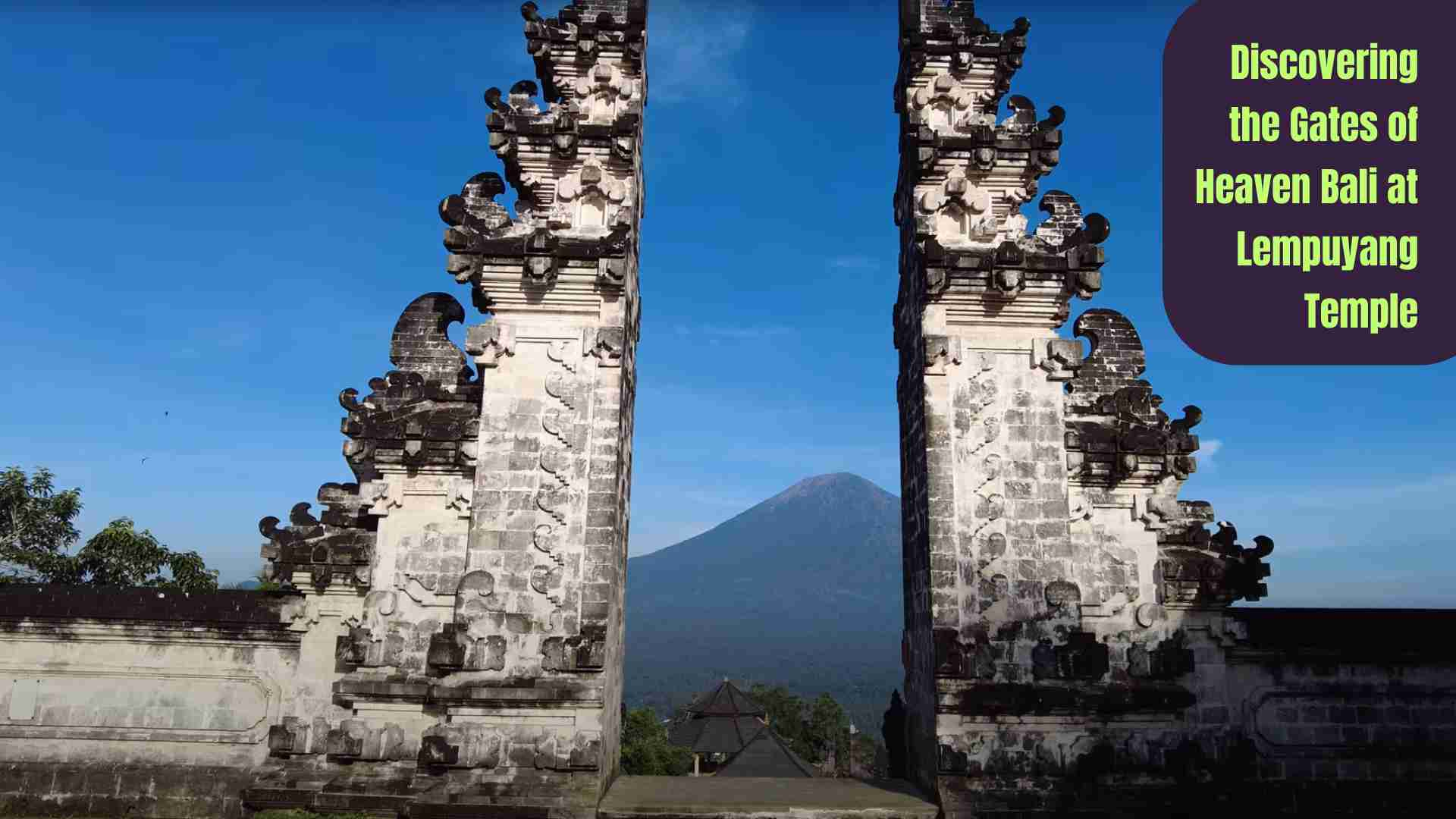If you’ve ever seen a photo of Bali with a majestic split gate mirroring the clouds and Mount Agung in the background, chances are you’ve already caught a glimpse of the famous Gates of Heaven Bali at Lempuyang Temple. But let me tell you—there’s so much more to this place than that viral Instagram image.
Located in East Bali, Lempuyang Temple is one of the island’s oldest and most sacred Hindu sites. It sits on the slopes of Mount Lempuyang, about 1,175 meters above sea level. Getting there isn’t exactly a quick stop. It’s roughly a 2.5-hour drive from Ubud or Seminyak. But the journey, winding through rice paddies and remote villages, is part of the magic.
When I first heard about the Gates of Heaven, I expected a simple photo op. What I found was a deeply spiritual place with a calm, almost otherworldly atmosphere. Locals come here not for photos but for prayer, and the quiet respect around the temple makes it feel sacred in a way that’s hard to put into words.
You don’t just arrive and snap a photo. Visiting the Gates of Heaven means stepping into a living piece of Balinese culture. The temple is part of a complex of seven temples, and if you’re up for a bit of a climb—over 1,700 steps, to be exact—you can explore the whole pilgrimage path. Most visitors, though, head straight to the famous gates at the base, also known as Pura Penataran Agung Lempuyang.
But before we dive into the photo craze and what to expect on-site, let’s talk about what the Gates actually symbolize—and why they matter far beyond the surface beauty.
The Symbolism Behind the Gates of Heaven
At first glance, the Gates of Heaven Bali at Lempuyang Temple might just look like two tall stone pillars. But these aren’t just any gates. In Balinese Hinduism, they’re called Candi Bentar—a traditional gateway used in temples across the island. What makes the gates at Lempuyang special is their alignment with Mount Agung, Bali’s tallest and most sacred volcano.
Locals believe Mount Agung is the home of the gods. So when you stand between the two stone towers and look out, you’re not just staring at a mountain—you’re facing the divine. The gates are a threshold between the physical world and the spiritual realm. Even if you’re not religious, it’s hard not to feel a shift in energy when you’re standing there, especially with the clouds moving slowly across the peak in the distance.
This isn’t a tourist gimmick. The temple predates many other landmarks on the island. It’s one of Bali’s Sad Kahyangan Jagad, or “six sanctuaries of the world,” believed to provide spiritual balance across Bali. Locals regularly make offerings and climb the many steps as part of spiritual pilgrimages, especially during the full moon or religious festivals like Galungan and Kuningan.
So yes, the photo is beautiful—but the real beauty of the Gates of Heaven is in the feeling you get while you’re there. Peaceful. Grounded. Small, in the best possible way.
Still, for many travelers, the photo is part of the reason they come. And there’s no shame in that—as long as you approach it with respect.
What to Expect When Visiting the Gates of Heaven Bali at Lempuyang Temple
Let’s talk logistics—because visiting the Gates of Heaven Bali at Lempuyang Temple isn’t as effortless as the dreamy photos suggest.
Getting There
If you’re coming from Ubud, Seminyak, or Canggu, expect a drive of 2 to 3 hours. The roads are decent, but the closer you get to the temple, the more winding and narrow they become. Hiring a private driver is the most comfortable option. Some travelers rent scooters, but unless you’re confident on steep roads, it’s better to ride with a local.
Entrance Fees and Dress Code
When you arrive, you’ll need to pay a modest entrance fee (around IDR 55,000 or about $3.50 USD), and it includes a sarong rental, which is required attire to enter the temple. Balinese temples are sacred spaces, so covering your legs and dressing modestly is a must.
Local guides might also offer to escort you through the complex, but they’re not necessary if you’re just visiting the gates. Still, hiring one can offer deeper insights into the temple’s history and symbolism.
The Famous Photo
Now, about that viral image—the mirror-like effect that makes it look like you’re floating above the sky? That’s not a natural reflection. It’s a clever trick using a piece of glass held under a smartphone camera. Local temple volunteers usually help you take the photo, and there’s often a queue—sometimes stretching to two hours or more, especially during peak times like late morning.
If you want to skip the crowds:
- Arrive before 7 AM. Not only is the lighting beautiful, but the line is usually short.
- Avoid weekends and local holidays, as both tourists and locals visit in greater numbers.
- Be patient. Everyone is there for that same magical moment, so a little kindness goes a long way.
Some might say the photo is overhyped, but standing there with Mount Agung behind you still feels surreal—whether you get the shot or not.
Beyond the Photo: Exploring the Lempuyang Temple Complex
While most travelers flock to the Gates of Heaven Bali at Lempuyang Temple for that iconic photo, few realize that the site is just one part of a much larger spiritual journey. The temple is actually part of the Pura Luhur Lempuyang complex, which includes seven temples spread along a steep mountain trail.
If you’re up for a real adventure—and a bit of a workout—you can climb the 1,700+ steps that wind up through lush forest and past several smaller shrines. Along the way, you’ll hear birds calling, smell incense from offerings, and catch glimpses of monkeys (so watch your snacks). It’s quiet, green, and filled with that unique Balinese mix of nature and prayer.
Each temple you pass has its own charm, but few foreigners make it all the way to the top. The journey takes about 2 to 3 hours round-trip, depending on your pace and fitness level. At the summit, you’ll find Pura Luhur Lempuyang, the holiest of the seven and one of Bali’s oldest temples. The view? Sweeping vistas of Bali’s east coast and (on clear days) Mount Agung standing tall in the distance.
This part of the experience isn’t about photos. There’s no “perfect angle” waiting at the top. It’s more about the journey, the serenity, and perhaps even a bit of spiritual reflection.
If you’re short on time or energy, sticking to the main gate is perfectly fine. But if you’re curious to go deeper—or just want to escape the crowds—a quiet hike up the mountain is a beautiful way to experience the temple’s true essence.
Final Thoughts: Is the Gates of Heaven in Bali Worth Visiting?
So, is the Gates of Heaven Bali at Lempuyang Temple worth adding to your Bali itinerary?
Honestly—yes, but with the right expectations.
If you’re only after the photo, you might find the long drive, early start, and queue frustrating. The “mirror effect” is cool, sure—but it’s created with a piece of glass and some smartphone trickery. Knowing that, some travelers feel underwhelmed. But here’s the thing: if you come for more than just the shot, this place has so much to offer.
There’s a deep sense of peace at Lempuyang. The breeze, the view of Mount Agung, the sound of prayer bells in the distance—it all makes you slow down. And in a destination as popular as Bali, that’s a rare and welcome gift.
Tips to Make the Most of Your Visit
- Go early: The light is beautiful, the air is cool, and the line is shorter.
- Be respectful: This is an active place of worship, not a photo studio.
- Don’t rush: Spend time exploring the grounds and soaking in the atmosphere.
- Consider the hike: If you’re feeling adventurous, the upper temples are quiet and spiritually moving.
- Bring cash: For entrance fees, snacks, and tipping your photo helper.
The Gates of Heaven Bali at Lempuyang Temple isn’t just a trending backdrop—it’s a doorway into Bali’s spiritual heart. And whether you leave with the perfect photo or not, chances are you’ll carry something more meaningful with you: a sense of calm, a touch of awe, and a reminder of how small we all are in the shadow of sacred mountains.


